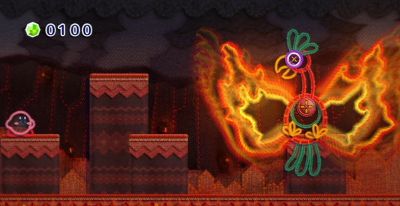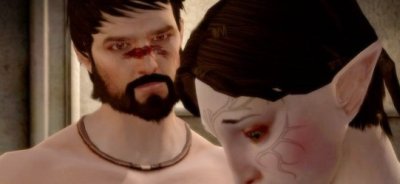The Legend of Zelda : Spirit Tracks

I usually do not play portable games unless I am unable to play “normal” ones; there really is no good reason for it other than me liking the format of traditional console (or PC) gaming. That being said, Spirit Tracks – like its predecessors filled with extra content and long playtime – is the kind of game that fits the format, and it is a bit disheartening not liking it more than I do. I remember feeling the same way about the Phantom Hourglass.
Speaking of the Phantom Hourglass, Spirit Tracks has a lot of the same strengths and weaknesses. Art is so-so except for the animations which are great. The quirky humor is funny and sometimes brilliant. The time spent getting between places by boat/train feels completely wasted – in Wind Waker the simple reason for this was to remove loading times, but there really is no excuse for these sessions on the DS. The controls still feel like the biggest issue.
In fact, the issue with the controls should be elaborated upon. A lot of puzzles in the game are a bit to illogical to be fun to solve, a lot of enemies are a bit to tricky to defeat to be intriguing to fight and in general a lot of the game require a bit too much precision to allow the player to pass. This is perfectly normal for a Zelda game – for any action-adventure game in fact – but usually controlling the protagonist is such a joy in itself that you do not mind much. With the stylus and microphone, even though a lot of work has obviously gone into it the controls are not smooth enough to make the experience flow and it quickly devolves into frantic scratching when the precision is not enough to solve a problem. The microphone controls are just as bad this time around (and does not work at all in certain environments).
On the one hand I wish Nintendo would just stop slapping control gimmicks on concepts that work well already (especially since they have proven time and again that they can innovate in level design alone) and on the other I know that there are games that use innovative controls for marvelous results. Spirit Tracks does little to innovate or change the things done in Phantom Hourglass though, and to me the DS-specific controls are a great step backwards for the playability of Zelda games.
Kirby’s Epic Yarn

I remember when the Nintendo DS first came out and it had this phase of rather shallow, gimmicky games – at the time, handheld games were usually just scaled-down console games and in the case of the DS developers simply opted to use the touchscreen and mike for some unimportant side feature. Then something happened and suddenly a lot of games were released that really took advantage of the format of the console and the possibilities of the input system, among these was the brilliant Kirby’s Canvas Curse. To some extent I expected this to happen to the Wii as well but it has yet to happen; to be fair the motion controls have a lot less precision and it is hard to do something useful with them but the games that are truly good and use the wiimote in a good way are few and far between. My point being that I had high hopes for Kirby’s Epic Yarn, so there was some initial disappointment that may color my reflection of it.
Kirby’s Epic Yarn does away with Kirby’s trademark feature of stealing enemies’ abilities on the fly and does not really replace it with anything of gameplay significance; it seems most of the time spent to give the game something unique was put in the aesthetic design. While this does make the game less varied and more linear, thankfully the level design is good enough that it is still a good platform game. It is a bit sad that they did not try to incorporate it in the game better as was done in Canvas Curse, though. Also, like most Kirby games it is very easy – the biggest setback you can suffer is to lose some score and in a Sonic-like fashion you can pick it right up again. I suppose the difficulty level could be explained by it being made for people who do not normally play platform games – or maybe games at all – and it is a credit to the designers that they manage to make interesting levels with so little challenge.
As for the aesthetics, the yarn and cloth theme is implemented incredibly well – animations with string moving around have a nice flow about them and the game is filled to the brim with small details that makes you smile. If anything, the concept of the entire world being sewn to a piece of cloth makes it look really flat at times, but at least the view doesn’t get cluttered.
It is a very nice platform game, really. Just not game-changing.
More Dragon Age 2

… So apparently there has been controversies surrounding Dragon Age 2 now. People have written about it – people who are professional writers and have already covered most of what I could add, so I will try to keep this brief. I should mention that I tend to side with the developers in cases like this since what usually boils down to “You didn’t make the game I wanted to play!” is not an argument for anything – I make no claims of being objective.
The game has been criticized for being derivative, dumbed down, a cash-in sequel failing in both high- and low-level design and whatnot, I can agree with most of this to some degree. The game design of Dragon Age 2 has not been tweaked for a smooth experience at all times. Some of this might be because of studio issues stemming from lingering problems from the recession – the game may have been hurried or people may have been moved to the team because of lack of work rather than a need for manpower. The games industry, like any other creative endevour turned into a billion dollar business, is more than anything a matter of compromise.
But I think that a lot of it is simply because the important part of the game is the story, more specifically the characters and the relations between them and the issues presented. I am reminded of a quote by Chris Hecker;
“People who are putting aliens and orcs into their games right now are not Philip K. Dick, Gene Roddenberry, nor Rod Serling, and do not need to resort to sci-fi and fantasy to deal with important social issues lest they be censored and not allowed to work in their chosen form. People who are putting aliens and orcs into their games right now just like aliens and orcs.”
… My point being that the supernatural elements in the Dragon Age universe manage to be just that; a veil to tell a story about important social issues. When you take stand on an issue it will affect characters – it will affect gameplay both directly through AI actions changing, and indirectly through the storyline changing and characters saying different things to you. By trying to stay true to your own ideals, you cannot make every character like you, and the game treats you differently for it. A friend and I spent lunch discussing our experiences with Dragon Age 2 and the game really grew for me. Even though we had played the same class and sided with the same factions, the difference in how the story played out was remarkable – he had solved situations I had thought impossible and vice versa. In the end, the things I remember most from both Origins and Dragon Age 2 are how going into a situation with good intentions could produce results that you really did not want. It felt wrong, but having a game invoke that feeling was special.
So I think most critique against the game is backwards; I would personally consider it a failure if a Dragon Age game did not make you feel uneasy. In the words of Tycho;
“That feeling, the one that you’re feeling? That is the game.“